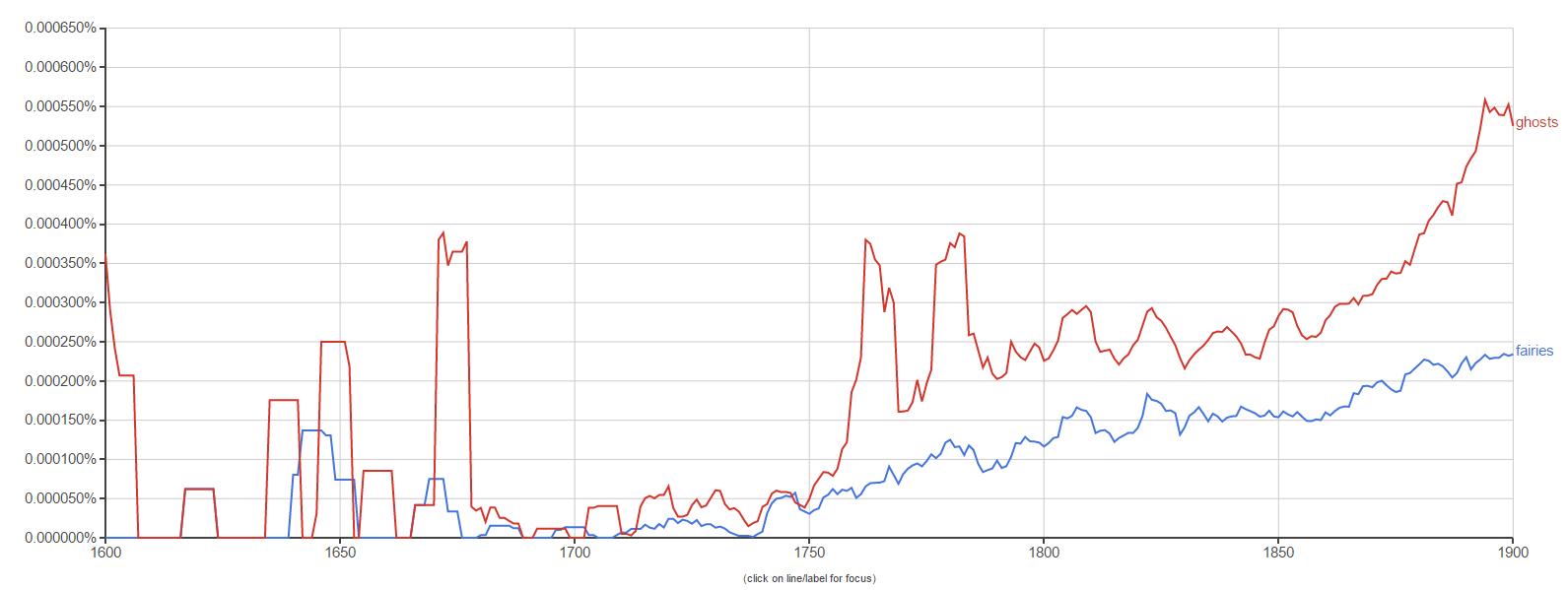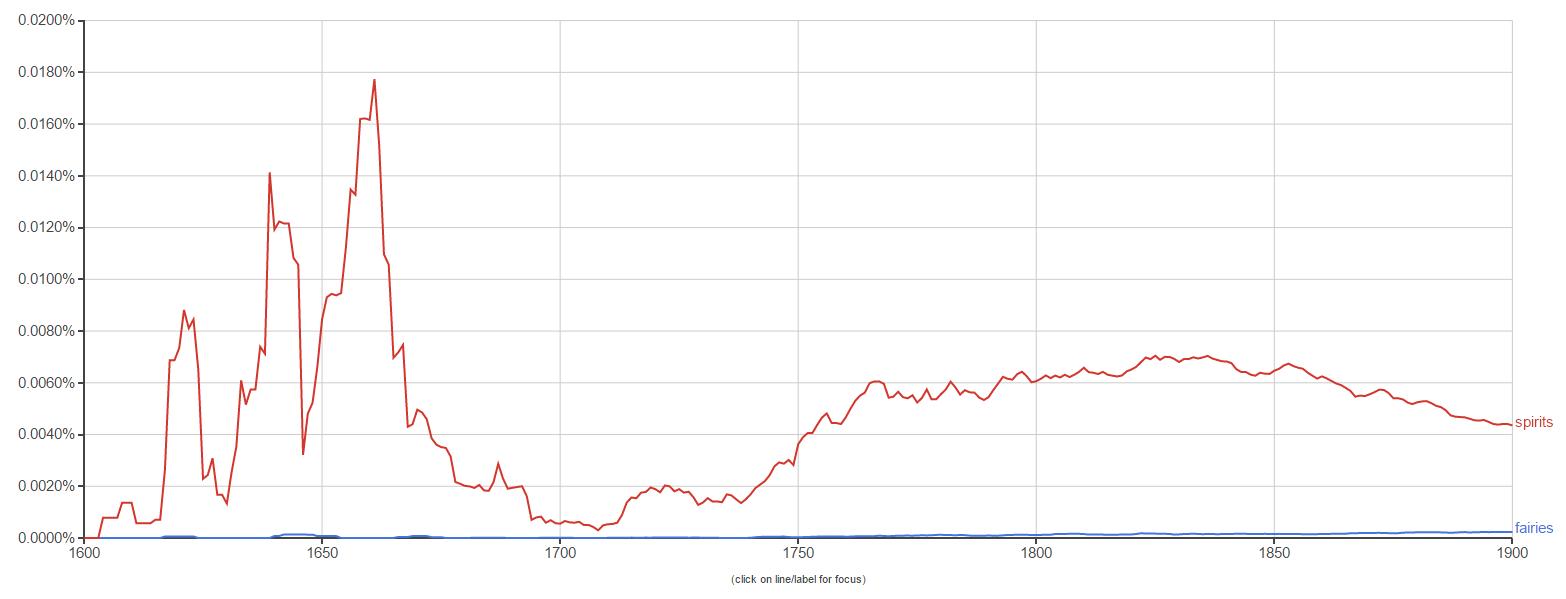In Search of the Anomaly Gap, 1700-1800 March 29, 2017
Author: Beach Combing | in : Modern , trackbackBeach has noted before on this site the way that in the enlightenment there is an ‘anomaly gap’. It becomes, from about 1700 to 1800, unfashionable to speak about the paranormal, even in jesting terms. Actually this is a very approximate rule. In Beach’s experience some forms of the supernatural are acceptable. For instance, ghosts continue to be of interest to writers, even the super-rational writers who were the standard bearers of the period. However, he has always been struck by how fairies simply vanish from the records or are described as ‘spirits’ or using some other very generic word.
It is very difficult to be empirical about impressions like this. How can you distill the wisdom (ahem!) of hundreds of hours of reading? Well, it is possible that that useful Google tool Ngram might be able to help. Beach has tapped in here two words: ‘fairies’ and ‘ghosts’ and set the period 1600 to 1900. Beach would really have expected something more radical, many more ghosts and much fewer fairies. According to the rather clunky looking data from the early period fairies actually overtake ghosts in some years in the early 1700s. Perhaps vocabulary is a problem. Adding phantoms reminds us that there were more synonyms for ghosts than for fairies.
If we can take Ngram at face value the fundamental lesson is that interest in the supernatural actually begins to close down in the mid-late 1600s and then grows through the second half of the 1700s. The enlightenment (understood as a period when there is less writing about the supernatural) is not 1700 to 1800, but 1670 to 1760. Note also that fairies recover from the anomaly gap less quickly and less completely than the undead. A final graphic. This is fairies vs. spirits. A similar trend and a reminder that interests in ghosts/spirits/phantoms was on another scale of values, though here too we see a dip and the frequency of words shows the early results much more clearly.
Insights into the anomaly gap: drbeachcombing At yahoo DOT com
The Great Mike Dash writes, 31 Mar 2017 ‘One problem with the ngram viewer data you present is that it gives no insight into what sort of mentions are being made in the old texts that the algorithm is searching. My experience of works dating to this period is that, especially by the latter half of the 18th century, there emerged quite a lively literature of enlightened, critical – even skeptical – commentary on strange phenomena of all sorts: some of it devoted to explaining how and why the great unwashed continued to believe so stubbornly in ancient superstitions, and some of it written to enlighten the members of said class as they emerged, blinking, into the Enlightenment. So I’d suggest that it’s more than possible, even quite likely, that the data shows not an increasing interest in strange phenomena after 1750, but an increasing interest in explaining strange phenomena away. I believe Keith Thomas has a few interesting things to say about these and related trends in his Religion and the Decline of Magic. Perhaps a post or two on him?’
Beach answers: I suspect that there are major problems with the ngram viewer that go beyond the comments here and this is something I’d like to explore in future posts. However, thinking of what Mike writes, for my purposes whether people are talking about ‘God’s marvels’ or dismissing the same or detailing the ignorant folk beliefs of the countryside is a secondary question. For whatever reason ink is being spilt on the supernatural and that means we can study changing attitudes. My strong impression – but what frustrates me, as noted above, is that it is just an ‘impression’ – is that there is a a massive fall off c. 1700-c.1800 in writing about the paranormal ‘even in jesting terms’. I would be very happy if there was time spent dismissing the supernatural because we would still learn a great deal. But, like sex with the Victorians, the supernatural becomes a no-go area for a great deal of eighteenth-century writing; and when there is supernatural writing it tends to stick to the question of the survival of death, i.e. ghosts and the afterlife. This at least is my “impression”. If you had, say, some bizarre footprints through the snow in Devon, interpreted by locals as the devil, you had better hope that this happened in 1855 rather than 1755 because in the second case it will be little documented. Of course, less is written in 1755 than in 1855, but my suspicion is that we would learn more even in 1655 than 1755. (?) Almost certainly we could find a similar Fortean event for the seventeenth, the eighteenth, the nineteenth and the twentieth century and trace attitudes in those four centuries, putting this thesis to the test. In the developing world an eclipse would do it. In the west it would have to be something else though… What? I know one supernatural site in northern England where we have records going back to the eighteenth century. It is fascinating to see how in the eighteenth century there are just the vaguest allusions to the supernatural (so vague that only subsequent writing allows us to interpret them), while these are fully fleshed out in the 19 and 20 cent. I am aware on writing on this that I’m a prisoner of my special interest in fairies and bogeys that were particularly offensive to the enlightenment mindset. Mike talks about ‘especially by the latter half of the 18th century’. My impression is that it is more like 1780 onwards and that is why the ngram results interests me. Certainly 1700-1780 is a desert for fairies: 1780-1850 is tundra, the rainforest only begins 1850. As to Keith Thomas… Thomas is something of a ‘whig’ in that he had a vision of wonder and magic draining out of the world to be replaced by science and reason. Like most academics he was a true child of the enlightenment. However, subsequent work has shown that there is no clear ‘upwards’ path. There was, say, much more interest in the supernatural world c. 1900 than c. 1750 among the educated. The enlightenment was a stair climbed, not a door closed, and for good or bad, we keep returning to the polished steps below.






